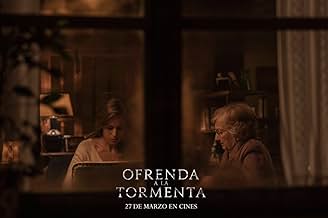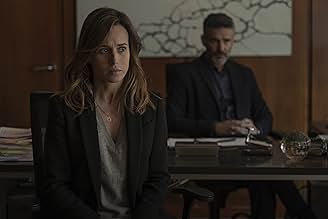CALIFICACIÓN DE IMDb
6.2/10
8.1 k
TU CALIFICACIÓN
Según la abuela, el padre intentó llevarse el cadáver mientras murmuraba algunas frases extrañas acerca de una ofrenda. La bebé tiene marcas rojas en la cara que indican un asesinato.Según la abuela, el padre intentó llevarse el cadáver mientras murmuraba algunas frases extrañas acerca de una ofrenda. La bebé tiene marcas rojas en la cara que indican un asesinato.Según la abuela, el padre intentó llevarse el cadáver mientras murmuraba algunas frases extrañas acerca de una ofrenda. La bebé tiene marcas rojas en la cara que indican un asesinato.
- Dirección
- Guionistas
- Elenco
- Premios
- 1 premio ganado en total
- Dirección
- Guionistas
- Todo el elenco y el equipo
- Producción, taquilla y más en IMDbPro
Opiniones destacadas
The Baztan trilogy is packed full of unusual happenings, murders and unexplainable events. I believe viewers were excited to see some of the unsolved mysteries come to a climax that would bring closure. Unfortunately, this is not the case at all! After hours of watching the characters get pushed to the limit, enduring horrific life-threatening circumstances and even some cryptic elements, we get cheated out of some answers.
Offering to the Storm holds one's attention with similar tactics that we see in the first two films. It's basically a fast pace crime drama with multiple twists and turns that loom over our main character pushing her to the brink. In the end, the villain turns out to be exactly who everyone thought it was, yet the writer took a very unsatisfying route. I honestly believe the characters, the film and the entire trilogy fall apart during the last half our. The last scene is so open-ended that it feels like there could be another sequel. That's a problem because a franchise has to have one element to keep a fanbase........interesting characters. This is especially true concerning the protagonist. Unfortunately she's just not very intriguing.
I enjoyed the first film, The Invisible Guardian, and was surprised that a certain someone wasn't revisited in the other films. I will not be viewing any of these a second time.
Offering to the Storm holds one's attention with similar tactics that we see in the first two films. It's basically a fast pace crime drama with multiple twists and turns that loom over our main character pushing her to the brink. In the end, the villain turns out to be exactly who everyone thought it was, yet the writer took a very unsatisfying route. I honestly believe the characters, the film and the entire trilogy fall apart during the last half our. The last scene is so open-ended that it feels like there could be another sequel. That's a problem because a franchise has to have one element to keep a fanbase........interesting characters. This is especially true concerning the protagonist. Unfortunately she's just not very intriguing.
I enjoyed the first film, The Invisible Guardian, and was surprised that a certain someone wasn't revisited in the other films. I will not be viewing any of these a second time.
The final installment of the Basque Trilogy, Ofrenda a la Tormenta (Offering to the Storm), is an action-packed, emotionally charged thriller that delivers a satisfying conclusion to the beloved series.
The film picks up shortly after the events of its predecessor, with Inspector Amaia Salazar (Marta Etura) still reeling from the traumatic birth of her son and the loss of her mother. As she struggles to balance her new role as a mother with the demands of her job, a new threat emerges in the form of a serial killer targeting infants.
The killer's MO is gruesome and personal: they kidnap babies and drown them in rivers, mirroring the near-death experience Amaia herself endured as a child, as depicted in the first film. This creates a deeply unsettling atmosphere and adds a layer of personal investment in the case for Amaia, pushing her to her limits both physically and emotionally.
The investigation takes Amaia back to her childhood hometown, where she must confront her own demons and the lingering shadows of her past. The stunning, misty landscapes of the Basque Country provide a haunting backdrop to the film, enhancing the sense of isolation and dread.
The performances in Offering to the Storm are exceptional. Marta Etura delivers a powerful portrayal of a woman grappling with postpartum depression and PTSD while trying to maintain her professional composure. Her vulnerability and strength are palpable, making her one of the most compelling characters in Spanish cinema in recent years.
The supporting cast is equally impressive. Leonardo Sbaraglia returns as psychiatrist Dr. San Martín, providing a calm and compassionate presence amidst the turmoil. Itziar Aizpuru is haunting as the ghostly presence of Amaia's mother, while Pedro Casablanc adds complexity as Amaia's father, whose role in the family's dark history is slowly unveiled.
Director Fernando González Molina masterfully builds tension, employing a mix of tight, intimate shots and sweeping landscape visuals. The film's pacing is relentless, with twists and turns that will keep viewers on the edge of their seats. The action sequences are expertly crafted, showcasing the production's impressive scale and attention to detail.
However, amidst the thrilling set pieces, the film occasionally loses focus on the deeper exploration of its themes. The intricate web of family secrets and the supernatural elements that were so effectively woven into the first two films feel somewhat rushed and underdeveloped here.
While the conclusion provides a sense of closure, it also feels a bit too neat and convenient, wrapping up various storylines in a way that might leave some viewers wanting more complexity. The inclusion of a few new characters, such as a potential love interest for Amaia, also feels unnecessary and takes away from the development of existing relationships.
Despite these minor shortcomings, Offering to the Storm is a gripping and emotionally resonant conclusion to the trilogy. It explores thought-provoking themes of motherhood, trauma, and the enduring impact of childhood experiences, all set against the stunning and evocative backdrop of the Basque Country.
The film picks up shortly after the events of its predecessor, with Inspector Amaia Salazar (Marta Etura) still reeling from the traumatic birth of her son and the loss of her mother. As she struggles to balance her new role as a mother with the demands of her job, a new threat emerges in the form of a serial killer targeting infants.
The killer's MO is gruesome and personal: they kidnap babies and drown them in rivers, mirroring the near-death experience Amaia herself endured as a child, as depicted in the first film. This creates a deeply unsettling atmosphere and adds a layer of personal investment in the case for Amaia, pushing her to her limits both physically and emotionally.
The investigation takes Amaia back to her childhood hometown, where she must confront her own demons and the lingering shadows of her past. The stunning, misty landscapes of the Basque Country provide a haunting backdrop to the film, enhancing the sense of isolation and dread.
The performances in Offering to the Storm are exceptional. Marta Etura delivers a powerful portrayal of a woman grappling with postpartum depression and PTSD while trying to maintain her professional composure. Her vulnerability and strength are palpable, making her one of the most compelling characters in Spanish cinema in recent years.
The supporting cast is equally impressive. Leonardo Sbaraglia returns as psychiatrist Dr. San Martín, providing a calm and compassionate presence amidst the turmoil. Itziar Aizpuru is haunting as the ghostly presence of Amaia's mother, while Pedro Casablanc adds complexity as Amaia's father, whose role in the family's dark history is slowly unveiled.
Director Fernando González Molina masterfully builds tension, employing a mix of tight, intimate shots and sweeping landscape visuals. The film's pacing is relentless, with twists and turns that will keep viewers on the edge of their seats. The action sequences are expertly crafted, showcasing the production's impressive scale and attention to detail.
However, amidst the thrilling set pieces, the film occasionally loses focus on the deeper exploration of its themes. The intricate web of family secrets and the supernatural elements that were so effectively woven into the first two films feel somewhat rushed and underdeveloped here.
While the conclusion provides a sense of closure, it also feels a bit too neat and convenient, wrapping up various storylines in a way that might leave some viewers wanting more complexity. The inclusion of a few new characters, such as a potential love interest for Amaia, also feels unnecessary and takes away from the development of existing relationships.
Despite these minor shortcomings, Offering to the Storm is a gripping and emotionally resonant conclusion to the trilogy. It explores thought-provoking themes of motherhood, trauma, and the enduring impact of childhood experiences, all set against the stunning and evocative backdrop of the Basque Country.
The film does not create the right atmosphere, the staging is weak and the cinematography poor, in general it doesn't achieve a good rythm, the structure is blurred
There's a mess of subplots and side plots so that most of the movie is filler for the central story. 2hrs 20 is a long slog for a pretty simple story if they just stuck to it but they have to drag along so much. Keep in mind also she's a terrible detective who does almost no detective work.
Not as good as the first two parts. Inspector Salazar also evolves into a creep screwing around on her husband and newborn baby. Disappointing storyline which didn't flow well.
¿Sabías que…?
- TriviaAs with previous installments El guardián invisible (2017) and Legado en los huesos (2019), the film was set to premiere theatrically in Spain (on March 27th 2020), followed by a streaming release in other countries through Netflix. However, due to the COVID-19 pandemic, it premiered on Netflix worldwide, including Spain.
- ErroresWhen Amaia goes to retrieve documents and finds that the woman working there has burned them all, she takes a picture of the woman landscape-style with her cell phone. In the next scene, she is talking to another woman and shows her the photo on her phone, but the photo is now portrait-style.
- ConexionesFollows El guardián invisible (2017)
Selecciones populares
Inicia sesión para calificar y agrega a la lista de videos para obtener recomendaciones personalizadas
- How long is Offering to the Storm?Con tecnología de Alexa
Detalles
- Fecha de lanzamiento
- Países de origen
- Sitio oficial
- Idiomas
- También se conoce como
- Offering to the Storm
- Locaciones de filmación
- Elizondo, Navarra, España(Amaia's home town, scenes on the bridge)
- Productoras
- Ver más créditos de la compañía en IMDbPro
- Tiempo de ejecución2 horas 19 minutos
- Color
- Relación de aspecto
- 2.35 : 1
Contribuir a esta página
Sugiere una edición o agrega el contenido que falta

![Ver Tráiler [OV]](https://m.media-amazon.com/images/M/MV5BYzM1MDRiYzEtODJlNC00ZGFhLWJlOTEtOTU1NDFiMDJhZmZlXkEyXkFqcGdeQXRyYW5zY29kZS13b3JrZmxvdw@@._V1_QL75_UX500_CR0)



































